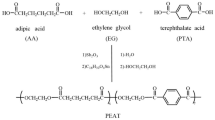Abstract
The cure behavior of the unsaturated (epoxy) polyesters based on different aliphatic glycols with styrene initiated by various types of organic peroxides or the mixture of an acid anhydride/organic peroxide has been studied by means of differential scanning calorimetry. unsaturated polyesters (UP) prepared from cyclohex-4-ene-1,2-dicarboxylic anhydride, maleic anhydride, and suitable aliphatic glycol: ethylene glycol or 1,4-butanediol or 1,6-hexanediol and unsaturated epoxy polyesters (UEP) obtained by chemical modification of UP were dissolved in vinyl monomer (styrene). The styrene solutions of polyesters were subjected to the cure reaction with suitable curing agent. The different organic peroxides: diacyl peroxide: benzoyl peroxide (BPO), dialkyl peroxide: dicumyl peroxide (DCP), and alkyl hydroperoxide: cumene hydroperoxide (CHP) were used. In addition, to cure the UEP, the mixture of the stoichiometric ratio of an acid anhydride (tetrahydrophthalic anhydride or hexahydrophthalic anhydride)/organic peroxide were applied. The curing characteristic such as: temperature of the cure initiation (T onset), peak maximum temperature (T max), final cure temperature (T end), the heat generated during the cure reaction (ΔH) were evaluated. It has been found that the course of the cure reaction of studied polyesters with styrene significantly depended on their structure and used initiating system. The presence of both carbon–carbon double bonds and epoxy groups in polyester backbone led to obtain more cross-linked materials where the copolymerization, thermal curing of epoxy groups with hydroxyl or carboxyl groups and polyaddition reaction of epoxy to anhydride groups have been expected. The use of BPO allowed to cure the polyesters at relatively lower temperatures with higher exothermic effect compared to DCP and CHP which was directly connected with lower thermal stability and significant higher ΔH values obtained during decomposition of diacyl peroxide used. In addition, the curing exotherm peak of polyesters based on glycol containing more –CH2– units with styrene was shifted to a bit higher temperatures which was probably due to lower molecular mobility of polyester’s chain caused the production of less stiff network structure.




Similar content being viewed by others
References
Pusatcioglu SY, Fricke AL, Hasster JC. Heats of reaction and kinetics of a thermoset polyester. J Appl Polym Sci. 1979;24:937–46.
Duswalt AA. The practice of obtaining kinetic data by differential scanning calorimetry. Thermochim Acta. 1974;8:57–68.
Martin JL. Kinetic analysis of an asymmetrical DSC peak in the curing of an unsaturated polyester resin catalysed with MEKP and cobalt octoate. Polymer. 1999;40:3451–62.
Avella M, Mortuscelli E, Mazzda M. Kinetic study of the cure reaction of unsaturated polyester resins. J Therm Anal. 1985;30:1359–66.
Yang H, Lee LJ. Comparison of unsaturated polyester and vinylester resins in low temperature polymerization. J Appl Polym Sci. 2000;79:1230–42.
Sarac AS. Redox polymerization. Prog Polym Sci. 1999;24:1149–204.
Sheppard J. Peroxy compounds in encyclopedia of polymer science and engineering, vol. 11. New York: Wiley; 1988. p. 1–21.
Martin JL, Cadenato A, Salla JM. Comparative studies on the non-isothermal DSC curing kinetics of an unsaturated polyester resin using free radicals and empirical models. Thermochim Acta. 1997;306:115–26.
Ellis B. Chemistry and technology of epoxy resins. London: Chapman and Hall; 1993.
Lee MY, Park WH. Epoxidation of bacterial polyesters with unsaturated side chains V. Effect of crosslinking on thermal degradation of epoxidized polymers. Polym Degrad Stab. 1999;65:137–42.
Hu YH, Chen Ch, Wang Ch. Viscoelastic properties and thermal degradation kinetics of silica/PMMA nanocomposites. Polym Degrad Stab. 2004;84:545–53.
Fish W, Hofmann W. Über den Härtungsmechanismus der äthoxylinharze. J Polym Sci. 1954;12:497–502.
Worzakowska M. Chemical modification of unsaturated polyesters. Influence of polyester’s structure on thermal and viscoelastic properties of low styrene content copolymers. J Appl Polym Sci. 2009;114:720–31.
Worzakowska M. The influence of chemical modification of unsaturated polyesters on viscoelastic properties and thermal behavior of styrene copolymers. J Therm Anal Calorim. 2009;96:235–41.
Worzakowska M. Studies on the cure reaction and thermal properties of NADIC/phthalic anhydride modified unsaturated (epoxy) polyesters. J Therm Anal Calorim 2009. doi 10.1007/s10973-009-0153-x (in press).
Grenet J, Maris S, Legras MT, Chevalier P, Saiter JM. DSC and TSDS study of unsaturated polyester resin. Influence of the promoter content. J Therm Anal Calorim. 2000;61:719–30.
Severini F, Gallo R. Differential scanning calorimetry study of the thermal decomposition of peroxides in the absence of a solvent. J Therm Anal Calorim. 1985;30:841–7.
Hou HY, Liao TS, Duh YS, Shu CM. Thermal hazard studies for dicumyl peroxide by DSC and TAM. J Therm Anal Calorim. 2006;83:167–71.
Ferrero F. Calorimetric analysis of the cross-linking reaction of epoxidized polybutadienes. J Therm Anal Calorim. 2006;83:373–8.
Hou HY, Duh YS, Lin WH, Shu CM. Reactive incompatibility of cumene hydroperoxide mixed with alkaline solutions. J Therm Anal Calorim. 2006;85:145–50.
Alberts H, Bartl H, Kuhn R. Grafting of styrene and acrylonitrile onto ethylene polymers. Adv Chem Ser. 1975;142:214–230.
Severini S, Gallo R. Differential scanning calorimetry study of thermal decomposition of benzoyl peroxide and 2,2′-azobisisobutyronitrile mixtures. J Therm Anal Calorim1984;29:561–6.
Stevens GC. Cure kinetics of a low epoxide/hydroxyl group-ratio bisphenol a epoxy resin-anhydride system by infrared absorption spectroscopy. J Appl Polym Sci. 1981;26:4259–78.
Worzakowska M. Thermal and dynamic mechanical properties of IPNS formed from unsaturated polyester resin and epoxy polyester. J Mater Sci. 2009;44:4069–77.
Acknowledgements
This article was supported by the European Community under a Marie Curie International Research Staff Exchange Scheme (IRSES), Project No 230790.
Author information
Authors and Affiliations
Corresponding author
Rights and permissions
About this article
Cite this article
Worzakowska, M. Curing reaction of unsaturated (epoxy) polyesters based on different aliphatic glycols. J Therm Anal Calorim 102, 745–750 (2010). https://doi.org/10.1007/s10973-009-0600-8
Received:
Accepted:
Published:
Issue Date:
DOI: https://doi.org/10.1007/s10973-009-0600-8




